Class 10 English Chapter 2.6 Question Answer Maharashtra Board
Balbharti Maharashtra State Board Class 10 English Solutions My English Coursebook Chapter 2.6 World Heritage Notes, Textbook Exercise Important Questions and Answers.
World Heritage Poem 10th Std Question Answer
My English Coursebook Standard Ten Guide Chapter 2.6 World Heritage Textbook Questions and Answers
Warming up!
Chit-chat:
1. I can talk about the world:
Form groups of 6 to 8 students. Each group should select any one Continent and share the following information about each.
1. Important cities
2. Sight-seeing places of tourist interest
3. Food speciality-cuisine
4. Wild life
5. Different types of region and vegetation.
6. Human life.
Now each group representative from the previously formed groups, should narrate the information to the class, using proper attractive sentences.
Question 1.
I can talk about the world:
Form groups of 6 to 8 students. Each group should select any one Continent and share the following information about each.
- Important cities
- Sight-seeing places of tourist interest
- Food specialty-cuisine
- Wild life
- Different types of region and vegetation.
- Human life.
Now each group representative from the previously formed groups, should narrate the information to the class, using proper attractive sentences.
Answer:
1. Important cities:
Mumbai, Tokyo, Hong Kong, Singapore, Dubai
2. Sight-seeing places of tourist interest:
Taj Mahal, Great Wall of China, Mount Fuji, Burj Khalifa etc.
3. Food speciality-cuisine:
Indian, Chinese, Middle-eastern
4. Wild life:
Tigers are naturally found in India. Panda’s are native to China.
5. Different types of region and vegetation:
Asia is blessed with a variety of regions including mountains, desserts, meadows, oceans etc. Some of the main crops grown in Asia are rice, grains, pulses, spices etc.
6. Human life:
Being the biggest continent in the world, Asia has diverse culture and each region within the continent have their own languages, festivals, religions etc.

2. Prepare a Travel Brochure or leaflet of your native place or any town/historical place/hill station to attract tourist using the points below.
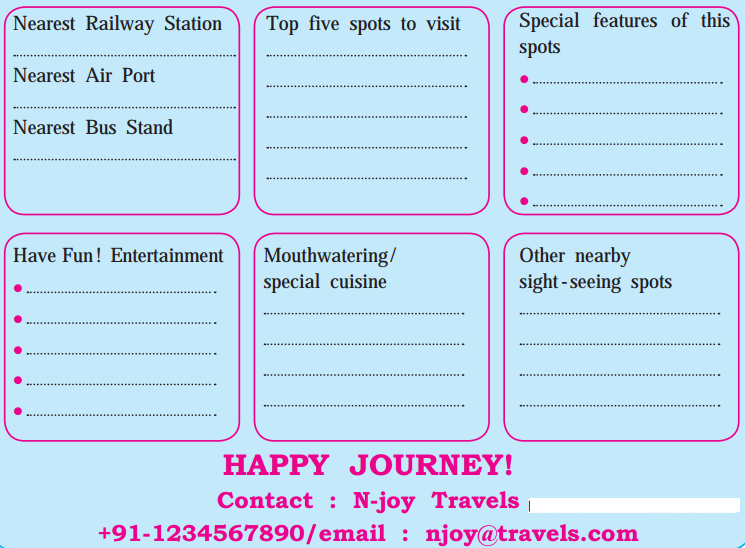
Answer:
Tourist Place: Koihapur
How to reach there?
- Nearest Railway Station: Chhatrapati Shahumaharaj Terminus (Koihapur)
- Nearest Air Port: Chhatrapati Rajaram Maharaj Airport, Kothapur Domestic Airport.
- Nearest Bus Stand: S.T. stand, Koihapur. Local transport is available.
Top five spots to visit: Mahalaxmi Temple, Panhala Fort, Rankala Lake, Maharaja Palace, Chhatrapati Shahumaharaj Museum, Gandharva Resort and Amusement Park.
Special features of these spots:
- Mahalaxmi Temple: Holy seat of Amba Mata.
- Rankala Lake: Famous for its beauty.
- Maharaj Palace: Magnificent structure of Chhatrapati Shahumaharaj’s palace, Indo-British architecture.
- Maharaj Museum: Great collections of historical period.
- Gandharva Resort and Amusement Park: Pleasant and attractive, beautiful site with amusing games.
Mouth-watering /special cuisines: Delightful tasty non-veg food, Pandhara Rassa, Tambda Rassa, Kothapur Misal/Bhel, Mohak lassi,
Davangiri Dosa, etc.
Other nearby sight-seeing spots: Panhala Fort, Kanheri Math, Radhanagari, Wildlife sanctuary.
For Further details contact
Vikas Tours & Travels
Mob.: 98xxxxxx34
email: [email protected]

English Workshop:
1. Write the importance of the years given below, with reference to World Heritage Sites.
Question 1.
Write the importance of the years given below, with reference to World Heritage Sites.

Answer:
| Year | Importance |
| 1959 | UNESCO launched an International campaign to protect temples and artifacts. |
| 1965 | White House Conference in United States called for a ‘World Heritage Trust’. |
| 1968 | The International Union for Conservation of Nature similar goals and presented them at the United Nations Conference on Human Environment. |
| 1972 | The Convention Concerning the Protection of World Cultural and Natural Heritage was adopted by UNESCO’s General Conference. |
| 2009 | 890 World Heritage Sites were located in 148 countries. |

2. Name the following.
Question 1.
(a) The country where Mount Huangshan is situated ……………………
(b) The famous dam in Egypt on River Nile …………………..
(c) The place where the conference based on Human Environment was held …………………..
(d) The country in which the highest number of World Heritage Sites are ……………………
(e) The body which can exclude a site from World Heritage list ……………………
Answer:
(a) The country where Mount Huangshan is situated in –
China
(b) The famous dam in Egypt on River Nile –
Anwan High Dam
(c) The place where the conference based on Human Environment was held –
Stockholm, Sweden.
(d) The country in which the highest number of World Heritage Sites are –
Italy
(e) The body which can exclude a site from World Heritage list –
World Heritage Committee.

3. Complete the following sentences.
Question 1.
Complete the following sentences.
(a) The World Heritage Sites include ……………….. .
(b) There are around ……………. World Heritage Sites in the world.
(c) The Role of World Heritage Committee is ………………. .
(d) The tenure of World Heritage Committee is ……………… .
(e) We can get more information about World Heritage Sites from its …………………. .
Answer:
(a) The World Heritage Sites include
cultural and natural areas
.
(b) There are around
890
World Heritage Sites in the world.
(c) The Role of World Heritage Committee is
to be responsible for establishing which sites will be listed as a UNESCO World heritage site.
(d) The tenure of World Heritage Committee is
six years
.
(e) We can get more information about World Heritage Sites from its
website at whc.unesco.org
.

4. Complete the following Web by giving reasons why World Heritage Sites are in danger.
Question 1.
Complete the following Web by giving reasons why World Heritage Sites are in danger.
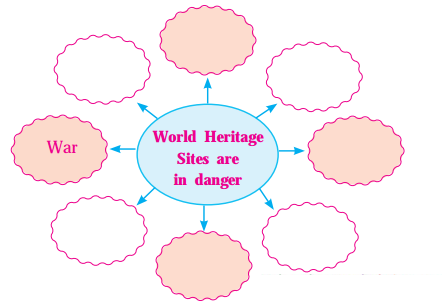
Answer:
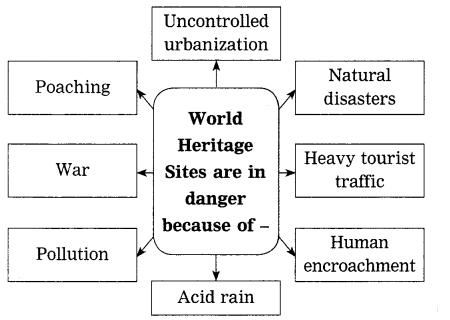
5. Answer in your own words:
Question a.
What are our duties towards preservation of any historical site?
Answer:
Historical sites like forts, monuments, palaces, etc. are our national heritage. They have stood all the vagaries of time and weather and are on the verge of losing their splendour. It is our duty to preserve them carefully. When you visit these places don’t spoil their beauty and grandeur by scratching, writing and carving names and making them look ugly and dirty. We must renovate them with the help of the residence in the area or NGOs. We should persuade and insist the government to take complete responsibility of preserving them as their foremost duty.

Question b.
Why should we preserve the World Heritage Sites?
Answer:
Our ancestors all over the world have bestowed upon us the spectacular, wonderful monuments, structures and sculptures, etc. They are the wonders of arts and architectures. The whole world feels proud of these ancestral treasures. They remind us of the past glory, art, culture and great, glorious memorials. They will continue to inspire us and give knowledge of patient and prolonged human endeavours such as the Taj Mahal, Ajanta Caves, Pyramids, China’s Great Wall and many other majestic structures. So, we must preserve them with utmost care.
Question c.
What is the role of World Heritage Sites in promoting tourism in any country?
Answer:
The ‘World Heritage Sites’ plays a very important role in promoting tourism in countries like India. The organisation is responsible, with the country’s contribution, for preserving the site and if required restore it, providing funds. If the site retains its original grandeur, splendour and beauty, flocks of passionate tourists from all over the world are sure to visit the site. Naturally, tourism of the site will flourish and it also will provide employment.

6. Read the following duties towards preservation of any historical site and make sentences about each of our duties.
- Obey rules and regulations – Visitors must obey the rules and regulations, displayed at the Entrance.
- Maintain discipline and order
- Maintain cleanliness
- Use dustbins and garbage bags
- Observe silence
- Maintain environmental safety
- Protect our country’s history/heritage.
Question 1.
Read the following duties towards preservation of any historical site and make sentences about each of our duties.
- Obey rules and regulations – Visitors must obey the rules and regulations, displayed at the Entrance.
- Maintain discipline and order
- Maintain cleanliness
- Use dustbins and garbage bags
- Observe silence
- Maintain environmental safety
- Protect our country’s history/heritage.
Answer:
- Obey rules and regulations – Visitors must obey the rules and regulations, displayed at the Entrance.
- Maintain discipline and order – All visitors must maintain discipline and order in the place.
- Maintain cleanliness – They should maintain cleanliness in the area.
- Use dustbins and garbage bags – They must use dustbins and garbage bags for throwing leftovers.
- Observe silence – Visitors must observe complete silence at the site.
- Maintain environmental safety – They should maintain environment safety for their own safety.
- Protect our country’s history/heritage – It is our duty to protect our countries historical heritage.

7. Complete the following flow – chart by choosing from the options given below to show how any site of any country can become a World Heritage Site.
Question 1.
Complete the following flow – chart by choosing from the options given below to show how any site of any country can become a World Heritage Site.

- Inclusion of the name of a site from the tentative list to the nomination file.
- Name of the site is inscribed on the World Heritage list after meeting the criteria.
- Inclusion of the name of site for the nomination in a tentative list after an inventory in the country or the state.
- Decision of the World Heritage Committee after review of the nominated file.
- A review of the file included by the advisory bodies.
Answer:
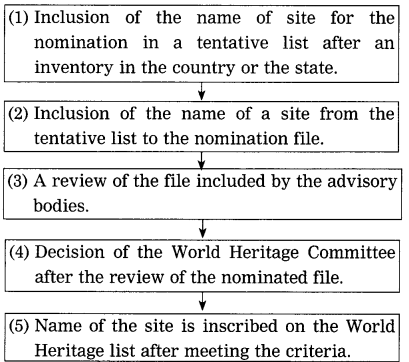
8. Match the pairs to defme different roles of the World Heritage Sites.
Question 1.
Match the pairs to defme different roles of the World Heritage Sites.
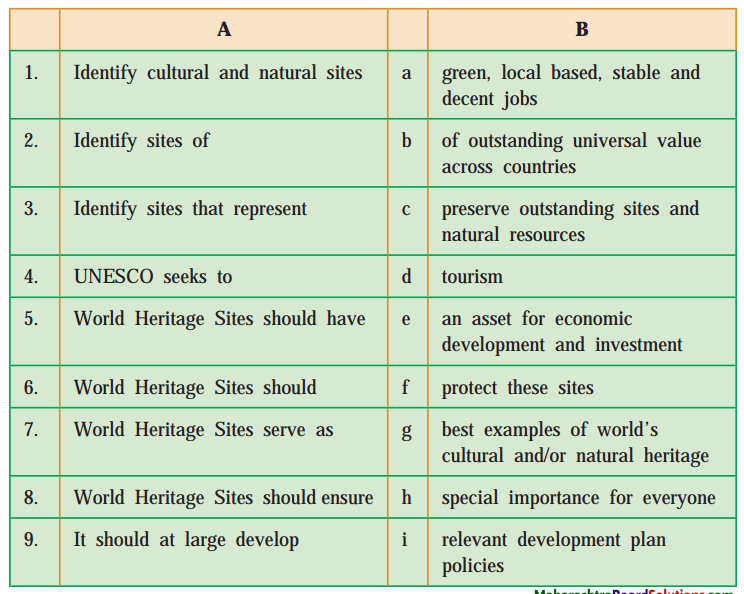
Answer:
| Column ‘A’ | Column ‘B’ |
| 1. Identify cultural and natural sites | (b) of outstanding universal value across countries. |
| 2. Identify sites of | (h) special importance for everyone. |
| 3. Identify sites that represent | (g) best examples of world’s cultural and/or natural heritage. |
| 4. UNESCO seeks to | (c) preserve outstanding sites and natural resources. |
| 5. World Heritage Sites should have | (i) relevant development plan policies. |
| 6. World Heritage Site should | (f) protect these sites. |
| 7. World Heritage Site serve as | (e) an asset for economic development and investment. |
| 8. World Heritage Site should ensure | (a) green, local based, stable and decent jobs. |
| 9. It should at large develop | (d) tourism. |

9. Do you know the difference between

Refer to a dictionary/encyclopedia/reference books/website/google search to get the detailed meaning.
Question 1.
Do you know the difference between:
- World heritage.
- Cultural heritage.
Refer to a dictionary/encyclopedia/reference books/website/google search to get the detailed meaning.
Answer:
World Heritage: As per UNESCO, World Heritage is the designation for places on Earth that are of outstanding universal value to humanity and as such, have been inscribed on the World Heritage List to be protected for future generations to appreciate and enjoy.
Cultural Heritage: Cultural Heritage means elements of great human value and creation. These could be tangible or intangible cultural heritage. Tangible Cultural Heritage include paintings, coins, sculptures, monuments, shipwrecks ruins, archaeological sites etc. Intangible Cultural Heritage can include traditions, performance arts, rituals etc.

10. Following are the ways to preserve ‘World Heritage Sites.’ Transfer these points into a small paragraph. Suggest a suitable title.
- Practical conservation of posterity
- Humanlanimal trespassing
- Unmonitored/uncontrolled/unrestricted access
- Threat of local administrative negligence
Question 1.
Following are the ways to preserve ‘World Heritage Sites.’ Transfer these points into a small paragraph. Suggest a suitable title.
- Practical conservation of posterity
- Humanlanimal trespassing
- Unmonitored/uncontrolled/unrestricted access
- Threat of local administrative negligence
Answer:
Preserving ‘World Heritage Sites’ for Future Generations Let us be sensible and practical to preserve our World Heritage Sites for future generations. It depends on well-organized and well-managed plan, The plan should be skillfully monitored and implemented to the details. It is the responsibility of the country where it is situated. So it is our national duty to protect or restore the Heritage Sites.
To maintain the original, natural characteristics of the site we must take utmost care and prevent them from being lost, damaged or destroyed. We must use funds and resources allocated by our state and the World Heritage Fund for mending and repairing work. Many a times, human and animal trespassing damage, deface and make them ugly and insecure.
Their activities and disturbances should be controlled and restricted to retain their natural beauty and grandeur. Buildings, structures, historical monuments and natural beauty should be taken care of.
In many cases, the local administrators are lethargic and they are responsible for the damages. The administrative apathy and negligence are the threats to our Heritage sites. Strict actions should be taken against them for their neglect to protect the sites.
Everyone of us, who visit the sites, should have a sense of national pride in preserving our World Heritage sites for the sake of our future generations.

11. Find from the text minimum 8 words related to cultural heritage and make a word register. Arrange them in an alphabetical order:
Question 1.
Find from the text minimum 8 words related to cultural heritage and make a word register. Arrange them in an alphabetical order:
Answer:
Words related to cultural heritage:
- temples
- culture
- literature
- artefacts
- sites
- territory
- monuments
- art
Alphabetical order: art, artefacts, culture, literature, monuments, sites, temples, territory.

13. Rewrite the following sentences using ‘not only but also’ and ‘as well as’ in 2 seperate sentences.
Question i.
UNESCO and the International Council on monuments initiated a draft convention to create an international organisation responsible for protecting cultural heritage.
Answer
1. Not only UNESCO but also the international council on monuments initiated a draft convention to create an international organisation responsible for protecting cultural heritage.
2. UNESCO as well as the International council on monuments initiated a draft convention to create an international organisation responsible for protecting cultural heritage.
Question ii.
The state parties are responsible for identifying and nominating new sites.
Answer
1. The State Parties are responsible not only for identifying but also for nominating new sites.
2. The State Parties are responsible for identifying as well as nominating new sites.

Question iii.
Opera House in Australia and the Historic Center of Vienna in Austria are cultural sites of World Heritage.
Answer
1. Not only Opera House in Australia but also the Historic Center of Vienna in Austria are cultural sites of the World Heritage.
2. Opera House in Australia as well as the Historic Center of Vienna in Austria are cultural sites of the World Heritage.
Question iv.
World Heritage Sites can be a combination of both cultural and natural areas.
Answer
1. World Heritage Sites can be a combination of not only cultural but also natural areas.
2. World Heritage Sites can be a combination of cultural as well as natural areas.
Question v.
To protect the temples and artifacts. UNESCO launched an international campaign.
Answer
1. To protect not only the temples but also artifacts, UNESCO launched an international campaign.
2. To protect the temples as well as artifacts, UNESCO launched an international campaign.

14. Rewrite the following sentences replacing ‘as soon as’ by ‘No sooner than.’
(Note: The phrase, ‘No sooner’ must always be followed by an auxiliary
(helping verb).
For example : As soon as he came, they all gave an applause.
No sooner did
he
come
,
than
all gave an applause.
(a) As soon as the Bill is passed, it will become an Act.
(b) As soon as the thief escaped, the family informed the police.
(c) As soon as you have finished, you can submit your answer – papers.
(d) As soon as they can manage, they should change their house.
(e) As soon as the bell will ring, the School Assembly will start.
Question 1.
Rewrite the following sentences replacing ‘as soon as’ by ‘No sooner… than…’
(a) As soon as the Bill is passed, it will become an Act.
(b) As soon as the thief escaped, the family informed the police.
(c) As soon as you have finished, you can submit your answer-papers.
(d) As soon as they can manage, they should change their house.
(e) As soon as the bell will ring, the School Assembly will start.
Answer:
(a)
No sooner
is the Bill passed
than
it will become an Act.
(b)
No sooner did
the thief
escape
than
the family informed the police.
(c)
No sooner have
you finished
than
you can submit your answer papers.
(d)
No sooner can
they manage
than
they should change their house.
(e)
No sooner will
the bell ring
than
the School Assembly will start.

15. Prepare a ‘tourism leaflet’ on any one of the following. (You may refer to the points given in Warming Up.)
(A) Your Home Town
(B) A Historical Place
(C) A Place of Natural Beauty
(D) A Place of Pilgrimage
Question 1.
Prepare a ‘tourism leaflet’ on any one of the following. (You may refer to the points given in Warming Up.)
(A) Your Home Town
(B) A Historical Place
(C) A Place of Natural Beauty
(D) A Place of Pilgrimage
Answer:
(उत्तराकरिता Warming Up! मधील Kolhapur विषयी दिलेले पर्यटन माहितीपत्रक पाहा.)
16.Project :
Question a.
Make a list of sites from our State that are included in the World Heritage Sites. Try to visit one of them. Write the importance of that World Heritage Site. Also write your impression of it in your notebook.

Live English:
Question a.
Making PowerPoint Presentation:
Answer:



Question b.
Rearrange the following steps of creating a PowerPoint slide in proper sequence:
(Answers is directly given.)
Answer:
- Open Microsoft PowerPoint.
- Click ‘New’ to create Blank Presentation.
- Add New Slide from Home menu.
- Click to add Text and Title in the slide.
- Add Pictures by clicking ‘Insert’ button.
- Resize your pictures or graphics.
- Add effects from “Transition” menu.
- Add New slide from Home menu.
- Save your slide and start slide show from the beginning.

Question c.
Follow the slide Handout on ‘Types of Sentences’ given on coursebook page No. 85. Create similar slide Handout on any one of given topics:
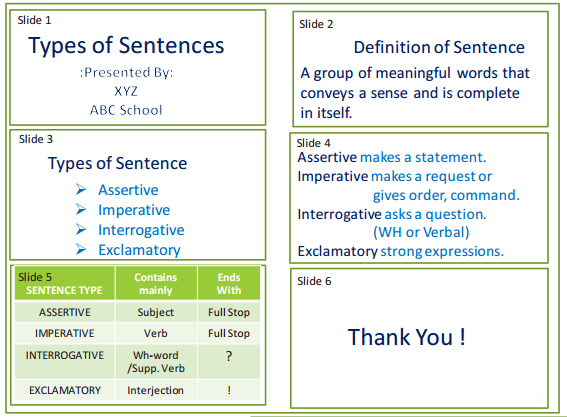
- pollution
- Modes of Transport
- Our Solar System
- The United Nations

Question d.
Tips for writing an effective Slide Handout
Answer:
- Begin with writing a Title and name of presenter on the Slide 1.
- Write points you want to explain in main bullet points in the Slide 2.
- Give meanings, definitions and exanples in bullet points.
- Use aphoristic style of language, give only main points.
- Give your contact number and email ID for feedback towards the en)
Question e.
Tips for making an effective Power point Presentation
Answer:
- While speaking, show your passion and use positive body gestures.
- Start strongly try to connect with your audience using propertone.
- Keep it simple: concentrate on your core message.
- Smile and make eye contact with your audience.
- Conclude on positive note.

Question f.
The 10/20/30 rule of Power Point
Answer:
( If you are notfamiliarwith the 10/20/30 Ruleof PowerPoint created way back in 2005 by Guy Kawasaki, here’s how it goes:
“The most effective Power Poin t presentations should
containno more than lOslides,
Iastno longer than 20 minutes,
and feature fontno smaller than 30 points.”
My English Coursebook 10th Digest Chapter 2.6 World Heritage Additional Important Questions and Answers
Read the following passage and do the activities:
Simple Factual Activities:
Question 1.
Name the following:
(Answers are directly given and underlined.)
Answer:
i. The International World Heritage Programme is administered by –
The UNESCO WORLD Heritage Committee
ii. The Nile valley contains many ancient –
Egyptian artifacts
.
Question 2.
Complete the following sentences:
(Answers are directly given and underlined.)
Answer:
A draft convention was started for creating an international organization responsible for protecting cultural heritage.

Question 3.
Name the following:
(Answers are directly given and underlined.)
Answer:
State parties are elected by the
World Heritage Centre’s General Assembly
.
Question 4.
Complete the following sentences:
(Answers are directly given and underlined)
Answer:
- The role of World Heritage Committee is to list the sites as – a UNESCO World Heritage Site.
- The tenure of World Heritage Committee is – six years .
- The World Heritage Committee consists of representatives from – 21 State Parties .

Question 5.
Complete the following sentences:
(Answers are directly given and underlined.)
Answer:
- The inventory of the State Party is called the Tentative List.
- Tentative List is included on the Nomination File.
- Two advisory bodies make recommendations to the World Heritage Committee.
- When the site is chosen it also becomes considered within the international community.
- 25 of the World Heritage Sites are considered mixed.
Complex Factual Activities:
Question 1.
Complete the web:
(Answer is directly given and underlined.)
Answer:
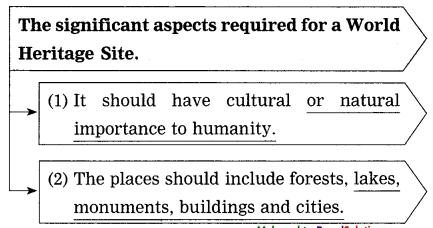
Question 2.
Why did UNESCO launch an international campaign in 1959?
Answer:
Egypt started plans to build the Aswan High Dam to collect and control water from the Nile River. The dam’s construction would have flooded the Nile valley containing the Abu Simbel Temples and many of ancient Egyptian artefacts. To protect the temples and the artefacts UNESCO launched an international campaign in 1959.

Question 3.
Complete the web:
(Answer is directly given.)
answer:
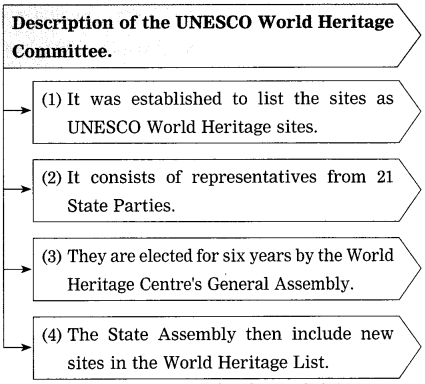
Question 4.
Why did a White House Conference in the United States call for a ‘World Heritage Trust’?
Answer:
A White House Conference in the United States called for a ‘World Heritage Trust’ to protect historic cultural sites and also for protecting the world’s significant natural and scenic sites.
Question 5.
What measures are taken about the World Heritage Sites that are in danger?
Answer:
The World Heritage Committee first prepares a separate list of sites that are in danger. The World Heritage Committee allocates resources from the World Heritage Fund to that site to restore it. In addition, different plans are put into place to protect and/or restore the site. However, if a site loses its characteristics which allowed it to be originally included on the World Heritage List, the World Heritage Committee can delete the site from the list.

Activities based on Vocabulary:
Question 1.
Look at the words and their meanings. Underline the correct alternatives:
(Answers are directly underlined.)
Answer:
(i) determine:
(a) think over
(b)
decide
(c) ask for
(d) look over
(ii) monument:
(a) statue
(b) pillar
(c)
memorial building
(d) fort
(iii) significant:
(a) clever
(b) effective
(c) systematic
(d)
important
(iv) disaster:
(a) problem
(b) incident
(c)
calamity
(d) accident

Question 2.
Find from the passage adjective forms for the following:
- culture
- history
- nature
- significance
Answer:
- cultural
- historical
- natural
- significant

Question 3.
Write the long form of ‘UNESCO’.
Answer:
United Nations Educational Scientific and Cultural Organisation.
Question 4.
Write from the passage nouns for the following:
- present
- protect
- conserve
- include
Answer:
- presentation
- protection
- conservation
- inclusion
Question 5.
Write the list of adjectives from the passage.
Answer:
historic, cultural, significant, natural, scenic, international, similar, general, main, responsible, six.

Question 6.
Match the words in Column ‘A’ with their meanings in Column ‘B’:
| Column ‘A’ | Column ‘B’ |
| 1. inventory | (a) fixed basis to judge |
| 2. territory | (b) suggestions |
| 3. criteria | (c) region |
| 4. recommendations | (d) a written list of material |
Answer:
| Column ‘A’ | Column ‘B’ |
| 1. inventory | (d) a written list of material |
| 2. territory | (c) region |
| 3. criteria | (a) fixed basis to judge |
| 4. recommendations | (b) suggestions |

Question 7.
Find from the passage the antonyms for the following:
- exclude
- artificial
- insignificant
- final
Answer:
- exclude × include
- artificial × natural
- insignificant × significant
- final × tentative
Question 8.
Find out opposites from the passage for the following:
Answer:
- artificial × natural
- lowest × highest
- exclude × include
- safe × danger

Question 9.
Find from the passage the nouns of the following :
- locate
- urbanize
- pollute
- add
Answer:
- locate – location
- urbanize – urbanization
- pollute – pollution
- add – addition
Personal Response:
Question 1.
Why do you like to visit tourist spots?
Answer:
I like to visit some tourist spots not only for comfort and relaxation but for expanding my knowledge and for knowing our culture, history and glory of the past. They enhance our knowledge, vision of life and enlighten your intelligence. These visits give us true education of life and soothe our minds.
Activity-based on Contextual Grammar:
Rewrite the sentences using ‘not only….but also’ and ‘as well as’ in two separate sentences:
Question 1.
A White House Conference called for a ‘World Heritage Trust’ to protect historic cultural sites and the world’s significant natural and scenic sites.
Answer:
i. A White House Conference called for a ‘World Heritage Trust’ to protect not only historic cultural sites but also the world’s significant natural and scenic sites.
ii. A White House Conference called for a ‘World Heritage Trust’ to protect historical cultural sites as well as the world’s significant natural and scenic sites.

Question 2.
Write the following sentence using ‘as soon as’ and ‘no sooner …… in two separate sentences.
Immediately after the World Heritage Sites are in danger, they are inscribed on a separate list.
Answer:
(i) As soon as the World Heritage Sites are in danger, they are inscribed on a separate list.
(ii) No sooner are the World Heritage Sites in danger than they are inscribed on a separate list.
English Workshop:
(based on whole lesson).
Question 1.
What is the difference between the words ‘World Heritage’ and ‘Cultural Heritage’?
Answer:
The word ‘World Heritage’ is related with the natural or man-made places that are recognized as having international importance, cultural values of the world and humanity in general. Whereas ‘Cultural Heritage’ is related with a particular society or groups, its ideas, customs, beliefs, art and literature, etc. that have existed and inherited from past generations, maintained in the present and preserved for the benefits of future generation.

Activities based on Language Study
(A) Do as directed:
Question 1.
Complete the words by using correct letters:
- w o _ l d
- l a k _ s
- s i _ e s
- s _ a t e
Answer:
- w o r l d
- l a k e s
- s i t e s
- s t a t e
Question 2.
Put the following words in alphabetical order:
1. world, becoming, property, territory
2. step, site, selection, significant
Answer:
1. becoming, property, territory, world
2. selection, significant, site, step
Question 3.
Punctuate the following sentences:
1. Then what’s the secret of your energy I asked
2. No there isn’t anyone like Raghu veer
Answer:
1. “Then what’s the secret of your energy?” I asked.
2. “No, there isn’t anyone like Raghuveer.”

Question 4.
Make four words (minimum 3 letters each) using letters in the word ‘ mountain ’
Answer:
mount, out, main, tin
Question 5.
Write related words as shown in the example:
(Answers are directly given and underlined.)
Answer:
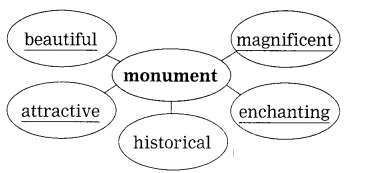
Question 6.
Complete the following word-chain of the adjectives. Add four words each beginning with the last letter of the previous word: ;
dear → …………… → …………… → …………… → …………… .
Answer:
dear → real → large → eager → red.

(B) Do as directed:
1. Attempt anyone:
Question a.
Make your own meaningful sentence using the phrase ‘to fall prey’:
Answer:
Young people fall prey to attractive, tasty food.
OR
Question b.
Add a clause to the following sentence to expand it meaningfully:
This is how I …………….
Answer: This is how the poor man got shelter in the Old age Home.

2. Attempt anyone:
Question a.
Add a prefix or suffix to make new words:
1. agree
2. satisfy
Answer:
1. disagree/agreement
2. satisfaction/dissatisfy
OR
Question b.
Make a meaningful sentence using any one of the following words:
1. agree
2. satisfy
Answer:
1. Do you agree with my opinion?
2. The food he got did not satisfy his hunger.